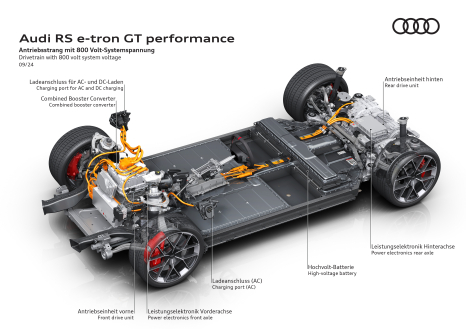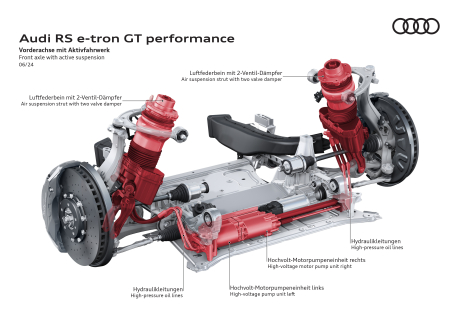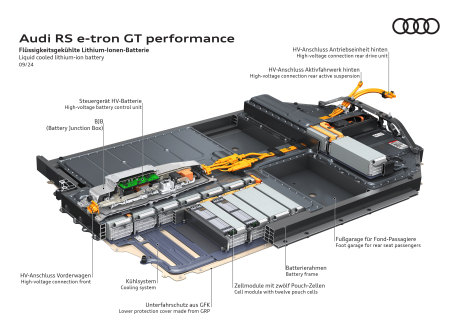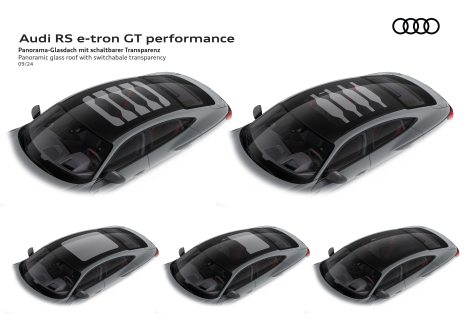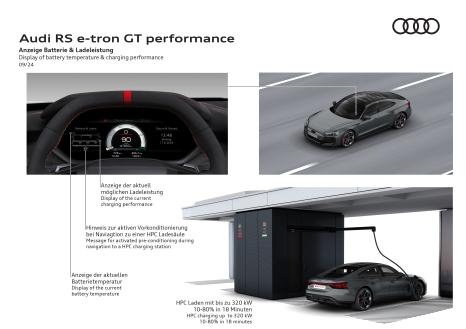Audi RS e-tron GT performance – Drive and performance
With the Audi RS e-tron GT performance, Audi is debuting its first fully electric RS performance model. The four-door coupé demonstrates bundled technical expertise – and Audi’s passion for details. Powerful, sporty, and confident, it reflects the brand’s high standards for developing and building cars. The RS e-tron GT performance is the dynamic flagship for electric mobility at Audi.
In addition to a permanent-magnet synchronous motor (PSM) on the front axle with a reinforced driveshaft and an output of 252 kW (342 PS), the electric Gran Turismo features a newly developed PSM on the rear axle with an output of 415 kW (564 PS).The increased copper density of the special hairpin winding in the electric motors’ stator maximizes current conduction. Moreover, the rotor in the electric motor at the rear is more compact and lighter. Overall, Audi has reduced the weight of the electric motor on the rear axle by ten kilos. What’s more, both electric motors have power reserves for dynamic driving situations. Launch Control can briefly use resources from the HV battery and the electric motors for an output of up to 680 kW / 925 PS (combined power consumption: 20.8–18.7 kWh / 100 km; combined CO2 emissions: 0 g/km; CO2 class: A).
One of the development goals for the performance model was high efficiency across all load ranges and repeat output availability. This makes for more reproducibility and superior performance. Adapted thermal management and intelligent interconnection of the four coolant circuits play a vital role – especially in RS performance mode, which is an exclusive feature of the top model. When increased output is used, the thermal management system switches on the AC circuit to ensure the HV battery is sufficiently cooled. The adapted cooling circuit conditions the interior while simultaneously and actively lowering the temperature in the coolant circuits of the HV battery and the two electric motors in the RS e-tron GT performance2. Cooling of the electric motors, interior air conditioning, and conditioning of the HV battery can now be controlled largely independently of each other. Audi made significant changes to pumps and valves to optimize the performance of the thermal management system.
The new cell chemistry is also partly responsible for the increased output of the RS e-tron GT performance2, with an adjusted mixing ratio of nickel, cobalt, and manganese and a gross storage capacity of 105 kWh (97 kWh net). This results in higher energy capacity and higher charging and driving currents compared to the predecessor model. The maximum charging currents have been increased to 400 amps. When Launch Control is activated, up to 1,100 amps of current can flow.
This is also the case when using the new push-to-pass function in the RS e-tron GT performance2, which provides a 70-kW increase in output at speeds above 30 km/h for up to ten seconds – as indicated by a timer in the virtual cockpit. When the driver activates push-to-pass, the battery uses the same map as for Launch Control. At the same time, the drive components automatically switch to the Audi drive select mode dynamic. After a minimum of ten seconds of regeneration, the function can be activated again. A new cooling plate with U-Flow architecture ensures homogeneous heat and cold transfer. The warmest cells in the HV battery always limit the charging current. At Audi, the guiding principle of “performance” also applies to the charging experience. The maximum charging power has been increased by 50 kW up to 320 kW. This allows the vehicle’s HV battery to charge from 10 to 80 percent in only 18 minutes at a high-power charging (HPC) station under ideal conditions.
09/2024
